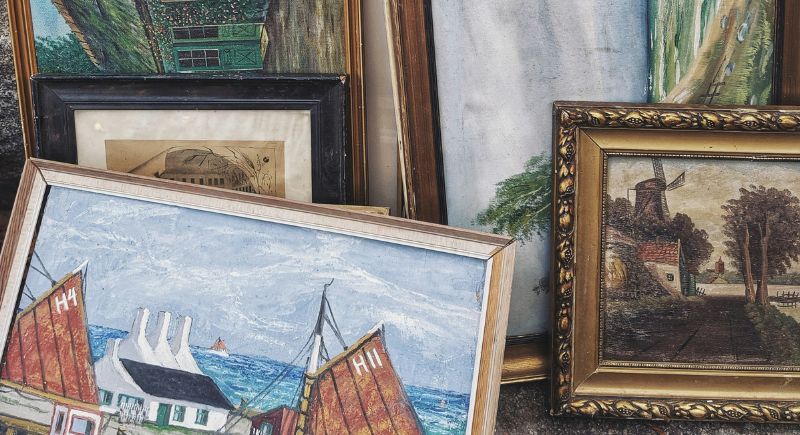A garage sale in Minnesota took a wild turn when someone bought an old painting for just $50. The artwork showed a white-bearded fisherman with a pipe, set against a dramatic seascape, and the name “Elimar” was scratched in the corner. At first, it just looked like an interesting old portrait. But a few years later, people started wondering if it might actually be worth $15 million—and possibly connected to none other than Vincent van Gogh. Here’s the story behind one of the most surprising art discoveries of this century.
According to the LMI Group, a New York-based firm focused on data science and art attribution, the painting may date to 1889, during Van Gogh’s final year of life. The group believes it matches the style, palette, and techniques he used while institutionalized in Saint-Rémy, where he created works like The Starry Night.
Their analysis began after acquiring the piece from the original buyer in 2019, and the results have reignited conversations about what qualifies as a legitimate Van Gogh. If true, it could be worth an estimated $15 million!
The artwork, named Elimar, bears a resemblance to a known portrait by well-known 19th-century Danish painter Michael Ancher, featuring fisherman Niels Gaihede. Van Gogh had a habit of reinterpreting other artists’ works using his own brushwork and color language. He must have admired Michael’s work. In his letters to his brother Theo, he described this process as translating rather than replicating.
LMI’s team, including scientists, curators, and art historians, approached Elimar from nearly every angle over the years. They weren’t just going to slap a Van Gogh label on it. Pigment testing showed materials consistent with those used in late 19th-century France. A glaze of egg-white, commonly used by Van Gogh to protect rolled canvases, was present.
A single hair embedded in the paint was DNA-tested and found to match the genetic traits of a man with red or reddish-brown hair. Van Gogh famously had ginger locks, a feature often noted in his self-portraits. Researchers also analyzed the inscription “Elimar” and found that its lettering closely matched the style of Van Gogh’s handwriting in other works, especially in the shapes of the Es, Ms, and As.
Though Van Gogh rarely signed his work traditionally, supporters of the attribution argue that such lettering links are meaningful in his case. He frequently painted working-class figures, including fishermen, as part of his interest in human resilience and solitude. There’s even speculation that Elimar might be a kind of older, imagined self-portrait of the artist staring out to sea.
LMI’s findings were presented in a 456-page report with scientific analysis, historical documentation, and visual comparisons. The researchers also pointed to Van Gogh’s interest in literature because Elimar appears in Hans Christian Andersen’s The Two Baronesses, one of the books the artist likely knew well. To them, this connection supported the painting’s origin story.
Still, Not Everyone Is Convinced

Image via Unsplash/Kadir Celep
The Van Gogh Museum in Amsterdam first saw the painting in 2019 after it was discovered at a garage sale, but at that time, it determined it was not an authentic Van Gogh. Since then, LMI Group has carried out extensive new research and submitted its findings, but as of now, the museum has not yet responded to this updated evidence.
LMI, for their part, wasn’t thrilled. They claim the museum took “less than one working day” to reject the report and didn’t physically examine the painting or provide an explanation for the rejection. LMI also points out that the museum’s opinions have changed in the past. Van Gogh’s Sunset at Montmajour, for example, was rejected for decades before finally being authenticated in 2013.
Art experts remain split on the use of data-driven analysis in verifying authorship. LMI’s approach combines traditional connoisseurship with tools like handwriting modeling, material dating, and forensic imaging. Similar methods have surfaced in other high-profile cases. In late 2024, a Swiss company used artificial intelligence to evaluate a watercolor by German Expressionist Marianne von Werefkin, which then helped it sell for nearly double its high estimate at auction.
But not everyone in the art world is on board. Museums and foundations often remain skeptical and point to the subjective nature of visual interpretation and the weight of historical records.
Still, without backing from a major institution, Elimar remains in limbo. The painting is being shown privately to art scholars and collectors, while LMI continues to seek formal recognition from additional experts in the field.
Vincent van Gogh created more than 2,000 paintings in a career that lasted barely a decade. Many of those works were never cataloged properly during his lifetime, and some were lost, given away, or discarded. So when something like Elimar surfaces, it carries weight in how it might reshape the record of one of history’s most enigmatic artists.
Regardless of what happens next, the story already feels like something out of a movie: anonymous collector, bargain bin discovery, global experts debating a single hair and a smudge of paint. Like much of Van Gogh’s legacy, it’s full of questions no one can fully answer yet.